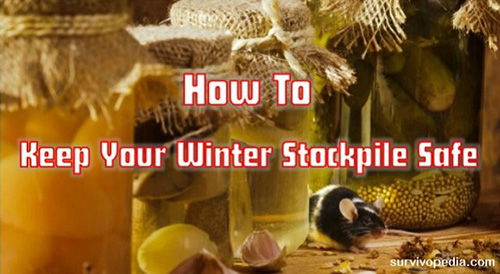Building your stockpiles is only part of the equation for survival. Once you have items stored up, you also must protect them all year long.

This winter, your reserves can be threatened in numerous ways. Are yours going to make it through until spring comes?
Here are five common threats that winter can bring. So you can adequately prepare, you’ll also find tips on how to avoid these threats. That way you can make it through the cold season with your supply stores intact.
How To Keep Your Winter Stockpile Safe
1. Threats from Extreme Cold
Have you ever put a can of pop in the freeze to cool off and forgotten about it? I did once in high-school, and it’s not a fun mess to clean up!
When liquids freeze, they expand. This can lead to containers breaking, loss of supplies, and a mess.
Similarly, canned goods can bulge when frozen, breaking the seal. Water stored improperly can freeze and burst.
Additionally, any items you’ve stockpiled with a high liquid content can suffer changes in texture and may separate into different layers. This includes things like:
- Toothpaste
- Hand soap
- Shampoo
- Shaving cream
- Paint
- Chemicals
- Foods with a lot of liquid like: condiments, evaporated milk, canned soup
To prevent damage and loss from extremely cold weather, make sure your supplies aren’t in an unheated area. If you must keep them where it’s cold, like in a garage or other outbuilding, take precautionary steps.
Run a small heater to keep the temperature above the freezing point. Or, add an extra layer of insulation to the area. You can even use straw bales to create a barrier around your stockpiles.
Here you can read more about protecting your water stores this winter. Do what you need to do to keep any items that could be damaged from freezing temperatures.
2. Threats from Flooding
Are your stockpiles in a room with water pipes running through? If your pipes freeze, they’re going to get soaked. Water can ruin many supplies quickly.
Mold is also a concern where there’s water damage. You definitely don’t want mold to get into your stockpiles.
To avoid any damage, ensure your pipes are ready for freezing weather. Insulate them. Run heat in the room. Keep some water flowing at night.
Video first seen on This Old House.
Patch any leaks before the dripping water freezes and causes problems. If you need a short-term solution, use plastic bottles to help.
You can also move your stores into containers that are more waterproof. For instance, large plastic totes can hold a lot, and will keep most of the moisture out if a pipe bursts.
Water pipes bursting aren’t the only threat water threat to your supplies. Check your storage areas. Be aware of other sources of water such as leaky cement walls, condensation and runoff from the thaw.
3. Threats from Pests
Do you know what the insects, mice, and other pests do when it gets cold outside? They typically try to find someplace warm to stay before winter sets in. That could be inside your home, outbuildings, or garage.
Stinkbugs and mice are more common to see indoors in the winter where I live. They start trying to get indoors in late fall, typically before the first snow. You might have different critters in your region.
No matter what pests are trying to get inside, you need to make sure your stockpiles are protected. Because it’s not fun to find a mouse nest inside your emergency go bag. Or mouse droppings on top of your food stores.
Those rodents can gnaw through so many things! You must store your stockpile properly to avoid spoilage.
Your stockpile should be pest proof year-round, but now is the perfect time to double check. Make sure the lids are tight on your containers. Ensure they are rodent and insect proof.
You might consider setting out traps for mice or other rodents as a prevention measure. Here is how to make a simple mouse trap.
Video first seen on Chris Notap.
If flying insects are a problem, hang up some fly strips to help eliminate them. That way you can stop the problem before it escalates.
After all, these emergency stores are for you and your family. Not to keep pests alive all winter long.
4. Threats from Loss of Service
Blackouts happen no matter where you live, especially in the winter. Entire cities have been left in the dark after damage to the grid caused by high winds. Damage from an EMP would be even more severe.
You must be prepared for loss of service. It’s a definite threat to your reserves.
Freezers Going Out
Are you relying on freezers to store most of your long-term food stores that you’ve prepared? In a power outage, your freezer won’t maintain the right temperature for more than a few days.
A generator can help. So can the great outdoors if your temperatures are below freezing. But you must have a plan in place to know where to move everything when the time comes.
A longer-term solution would be to move your stores to the pantry through canning or dehydration. Canned goods are shelf-stable and aren’t threatened by loss of power, if they don’t freeze.
Water Freezing
When there’s no power, there’s no way to pump water. If you live in the city, you might not always lose your water for a short power outage, but those out in the country will. Regardless, you need water on hand.
Water freezes when it the temperature drops. But, you’ll still need liquid drinking water each day, along with enough water to take care of hygiene and everything else.
If you have a woodstove with a cooktop, you can melt your stored ice until it turns back into a liquid. But, that adds time and energy exertion to your day.
Keep at least a few days’ worth of water stored in your house where it won’t freeze. That’ll give you a few days to figure out your long-term plan. If you have animals, remember you’ll also need a way to keep them hydrated for the duration of the outage.
Heat Source
What’s your backup plan for heat? When services go out, you’ll need to make sure you and your stockpiles don’t freeze.
Ice buildup can cause problems even with your backup energy, so be sure to think through a winter plan.
Light
Will you be able to find what you need in your stores if you’re working in the dark? You don’t want to knock over and break something while you’re pawing around.
To prepare, make sure you have a couple of flashlights or oil lanterns easily accessible. Along with those should be batteries or the fuel you need. Check on these a few times throughout winter and ensure everything is in good working order.
Then when the power goes out, you’ll know exactly where to go for light. You’ll be able to see your reserves clearly and avoid damaging anything.
5. Threats from Thieves
Not everyone believes in the necessity of building a stockpile. When times get tough, like they can over a long, hard winter, those unprepared people can quickly run out of needed items. If they know that you have plenty, or can see your supplies while driving by, you’re at bigger risk for thievery.
Thievery isn’t only limited to harsh weather, so take time now to secure your stores and make them harder to access. Here are some tips for keeping possession of your goods:
- Build your woodpile out of sight of the main road, along with any other items stored outdoors.
- Learn how to make your stores blend in naturally to their surroundings, hiding them in plain sight.
- Hide your valuables in unusual locations instead of places thieves commonly look
- Don’t tell your neighbors or anyone details about your stockpile. Stay silent.
- Stay under the radar when the power goes out. Don’t flash your powerful generator, your ability to prepare food, or anything else.
You don’t want everything you worked hard to prepare to be snatched. It can happen when you least expect it.
 Also, make sure you check on your stores frequently. My family once had several cords of wood stolen out of our barn during the daytime, while we were out. We noticed it right away because we accessed the wood daily, and the thieves knocked over a good chunk of our woodpile.
Also, make sure you check on your stores frequently. My family once had several cords of wood stolen out of our barn during the daytime, while we were out. We noticed it right away because we accessed the wood daily, and the thieves knocked over a good chunk of our woodpile.
It looked different, and we went over to investigate. A lot of wood was missing, and there were tire tracks all over the fresh snow.
Instead of just lamenting over the loss, we acted. We realized that our woodpile was visible to anyone who drove up the driveway. So we jumped in and moved it right away.
Learn from my mistake, and do your analyzing before a thief does. Keep your goods out of sight and safe, and check on them throughout the winter.
Source: survivopedia.com
Living without power, cars, electronics or running water may seem like a nightmare scenario but to pioneers it was just the way life was. Having the skills to survive without modern conveniences is not only smart in case SHTF, it’s also great for the environment. Keep in mind that the key to a successful homestead does not only lie on being able to grow your own food but on other skills as well. Learning these skills will take time, patience and perseverance, and not all of these skills are applicable to certain situations. Hopefully, though, you managed to pick up some great ideas that will inspire you and get you started! We gathered all this lost knowledge in one place…an almost 400 pages guide called The Lost Ways.
Here’s just a glimpse of what you’ll find in The Lost Ways:
Table Of Contents:
Making Your Own Beverages: Beer to Stronger Stuff
Ginger Beer: Making Soda the Old Fashioned Way
How North American Indians and Early Pioneers Made Pemmican
How Our Forefathers Built Their Sawmills, Grain Mills,and Stamping Mills
How Our Ancestors Made Herbal Poultice to Heal Their Wounds
What Our Ancestors Were Foraging For? or How to Wildcraft Your Table
How Our Ancestors Navigated Without Using a GPS System
How Our Forefathers Made Knives
How Our Forefathers Made Snow shoes for Survival
How North California Native Americans Built Their Semi-subterranean Roundhouses
 Our Ancestors’Guide to Root Cellars
Our Ancestors’Guide to Root Cellars
Good Old Fashioned Cooking on an Open Flame
Learning from Our Ancestors How to Preserve Water
Learning from Our Ancestors How to Take Care of Our Hygiene When There Isn’t Anything to Buy
How and Why I Prefer to Make Soap with Modern Ingredients
Temporarily Installing a Wood-Burning Stove during Emergencies
Making Traditional and Survival Bark Bread…….
Trapping in Winter for Beaver and Muskrat Just like Our Forefathers Did
How to Make a Smokehouse and Smoke Fish
Survival Lessons From The Donner Party
Get your paperback copy HERE
WHAT TO READ NEXT:
5 TECHNIQUES TO PRESERVE MEAT IN THE WILD YOU SHOULD PRACTICE
HOW TO MAKE YOUR OWN BACON (STEP BY STEP GUIDE)
A RETURN TO THE OLD PATHS: HOW TO MAKE PEMMICAN LIKE THE NATIVE AMERICANS
20 LOST RECIPES FROM THE PIONEERS: WHAT THEY COOKED ON THEIR JOURNEY WESTWARD
SEVEN CLASSIC GREAT DEPRESSION ERA RECIPES GRANDMA USED TO MAKE
POTTED MEAT: A LOST SKILL OF LONG TERM MEAT STORAGE
BACK TO BASICS: HOW TO MAKE AND PRESERVE LARD
THE BEST WAY TO STOCKPILE VEGETABLES OFF-GRID
OLD FASHIONED PRESERVING-GRANDPA’S RECIPE FOR CURED SMOKED HAM
HOW TO MAKE GUNPOWDER THE OLD FASHIONED WAY
SURVIVAL HERBAL RECIPES FROM OUR ANCESTORS
HOW TO PRESERVE MEAT FOR SURVIVAL LIKE OUR GRANDFATHERS
OTHER USEFUL RESOURCES:
The 3 Pioneer Survival Lessons We Should Learn
The Most Effective Home Defense Strategies
Old School Hacks for Off-Grid Living
The Medical Emergency Crash Course
The Smart, Easy Way to Food Independence
How to Survive the Coming 100 Years Long Drought
Lisa Tanner loves living life down on the family farm with her husband and their seven children. She spends her day tackling farm chores, homeschooling the kids, and growing her freelance writing career.In her free time, Lisa loves cooking, reading, and trying to learn new skills. You can find her blogging over at maggiesmilk.com
